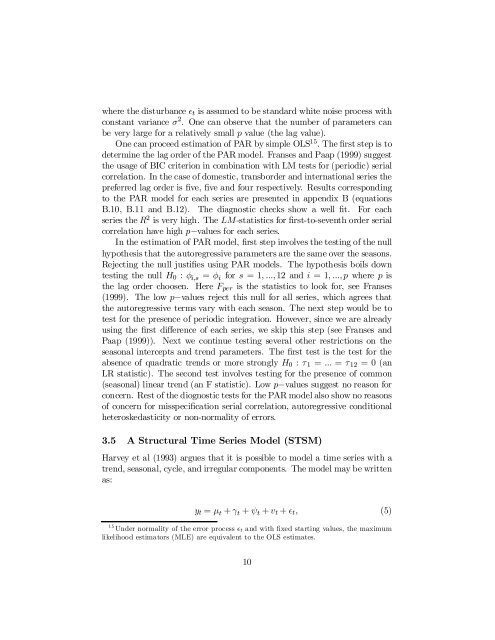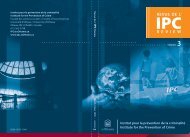0306E - Faculty of Social Sciences - Université d'Ottawa
0306E - Faculty of Social Sciences - Université d'Ottawa
0306E - Faculty of Social Sciences - Université d'Ottawa
You also want an ePaper? Increase the reach of your titles
YUMPU automatically turns print PDFs into web optimized ePapers that Google loves.
where the disturbance ² t is assumed to be standard white noise process with<br />
constant variance ¾ 2 . One can observe that the number <strong>of</strong> parameters can<br />
be very large for a relatively small p value (the lag value).<br />
One can proceed estimation <strong>of</strong> PAR by simple OLS 15 . The …rst step is to<br />
determine the lag order <strong>of</strong> the PAR model. Franses and Paap (1999) suggest<br />
the usage <strong>of</strong> BIC criterion in combination with LM tests for (periodic) serial<br />
correlation. In the case <strong>of</strong> domestic, transborder and international series the<br />
preferred lag order is …ve, …ve and four respectively. Results corresponding<br />
to the PAR model for each series are presented in appendix B (equations<br />
B.10, B.11 and B.12). The diagnostic checks show a well …t. For each<br />
series the R 2 is very high. The LM-statistics for …rst-to-seventh order serial<br />
correlation have high p¡values for each series.<br />
In the estimation <strong>of</strong> PAR model, …rst step involves the testing <strong>of</strong> the null<br />
hypothesis that the autoregressive parameters are the same over the seasons.<br />
Rejecting the null justi…es using PAR models. The hypothesis boils down<br />
testing the null H 0 : Á i;s = Á i for s = 1; :::; 12 and i = 1; :::; p where p is<br />
the lag order choosen. Here F per is the statistics to look for, see Franses<br />
(1999). The low p¡values reject this null for all series, which agrees that<br />
the autoregressive terms vary with each season. The next step would be to<br />
test for the presence <strong>of</strong> periodic integration. However, since we are already<br />
using the …rst di¤erence <strong>of</strong> each series, we skip this step (see Franses and<br />
Paap (1999)). Next we continue testing several other restrictions on the<br />
seasonal intercepts and trend parameters. The …rst test is the test for the<br />
absence <strong>of</strong> quadratic trends or more strongly H 0 : ¿ 1 = ::: = ¿ 12 = 0 (an<br />
LR statistic). The second test involves testing for the presence <strong>of</strong> common<br />
(seasonal) linear trend (an F statistic). Low p¡values suggest no reason for<br />
concern. Rest <strong>of</strong> the diognostic tests for the PAR model also show no reasons<br />
<strong>of</strong> concern for misspeci…cation serial correlation, autoregressive conditional<br />
heteroskedasticity or non-normality <strong>of</strong> errors.<br />
3.5 A Structural Time Series Model (STSM)<br />
Harvey et al (1993) argues that it is possible to model a time series with a<br />
trend, seasonal, cycle, and irregular components. The model may be written<br />
as:<br />
y t = ¹ t + ° t + Ã t + v t + ² t ; (5)<br />
15 Under normality <strong>of</strong> the error process ²t and with …xed starting values, the maximum<br />
likelihood estimators (MLE) are equivalent to the OLS estimates.<br />
10
















